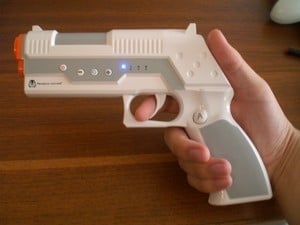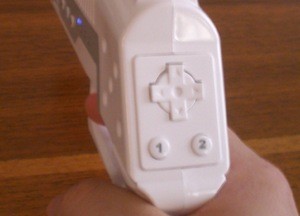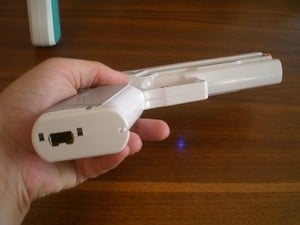
Thanks to the built-in pointer capabilities of the Wiimote, light gun games have seen a renaissance of sorts on Nintendo’s little white box. Connoisseurs of this genre have a load of accessory options in the shape of plastic shells a la Nyko’s lauded Perfect Shot, or Nintendo’s own Zapper.
But those are just shells; so far there hasn’t been much in the way of one-unit blasters.
Enter Penguin United. Advertising their CrossFire Remote Pistol as the first integrated gun/Wiimote combo, it certainly stands out in an increasingly crowded market on that fact alone. It also stands out on price: the MSRP $40 USD tag is the cost of a first-party Wiimote and significantly more than your vanilla gun shell. After spending the better part of a week with one it’s clear that it offers more in functionality than the competitors, but the question is whether you really need it to?
When Penguin calls it an integrated controller, they’re not kidding. Besides the fully-functional trademark IR element and accelerometers (good enough to bowl with), there’s rumble, a decent (for a controller) speaker and a pass-through port on the bottom of the handle that's compatible with a nunchuck but not MotionPlus. Probably the most significant difference from other shell attachments is button layout; now spread across all sides of the peripheral, you have easy access to  ,
,  ,
,  ,
,  and the D-Pad.
and the D-Pad.  is even on both sides of the controller to allow for lefty and righty use.
is even on both sides of the controller to allow for lefty and righty use.

Because of their pick-up-and-play arcade heritage, light gun games typically don’t require much more than a trigger and possibly a grenade button, so for Sega shooters like the House of the Dead series and Ghost Squad the wealth of buttons is borderline overkill. Resident Evil: The Umbrella Chronicles is a little more complex in this regard but works just fine. Taking things up a notch, The Conduit is perfectly playable with the CrossFire; you may have to remap some buttons, but everything vital can easily be reached. Metroid fared worse since it requires access to  and
and  , which are on the side of the controller and a pain to reach frequently.
, which are on the side of the controller and a pain to reach frequently.
Third-party controllers tend to have stiffer, “clickier” buttons that feel kind of cheap, and the CrossFire is no exception to this cliché. It’s hardly unplayable, but being used to the softer buttons of the Wiimote it definitely is noticeable. The trigger works well; it allows for quick pulls and springs right back. A dual-wield comparison of the CrossFire and Perfect Shot during a Dead-a-thon felt to give a slight edge to the new challenger, but the difference wasn’t significant enough to impact gameplay.
Since the Wiimote isn’t attached, weight distribution is less front-heavy than on shells; like a regular pistol, the handle is where most of the weight lies. The handle is also slimmer and less rigid than the Perfect Shot’s, so smaller hands will have an easier time playing for extended sessions.

Looking at it strictly as a light gun for Wii, the CrossFire is easily the new top dog for arcade shooter fans for it’s smart layout and controller integration. However, from a $40 standpoint it’s tough to recommend to those that play a light gun game once in a blue moon. Yeah, sure, you get essentially a whole controller, but you can also get a good similar-in-function shell attachment for a quarter of the price. It’s worth looking into for diehard fans of the genre, but everyone else is probably fine with shells.

Comments 20
Nice hand-gun, really expensive though!
That gun looks cool!
Yah like water warfare.
It looks awesome, the price is too high i agree. It would be perfect for DeadSpace extraction. How about a wii- plasma cutter-mote? It could have reusable skins, on par with the dead space dlc.
this actually looks like one of the best Wii controller for shooters,i'm not into shooters but i have friends who are
no thanks, im fine with my zapper
Funny! Just this morning I was talking about how the Wii needs a proper Lightgun and here it is!
Wow, this looks like an excellent gun that solves all the problems with regular shooters. I absolutely love the Wii Zapper, but some games (like the Conduit) really need all the buttons and this would be a great solution. But I still love the Wii Zapper to death.
I'm impressed, thanks for the overview. I need to get this before I play RE4 again, me like.
I don't buy anything Nintendo doesn't make.
Very nice. Just in time for RE:DC and Dead Space: Extraction
must-have for my 4th wiimote.
I've gotta get this for those of you complaining about the price, it's cheaper and better quality than buying a Wiimote plus a gun shell. The Wii Zapper for crossbow shooting was a cumbersome piece of junk from the get go. I'd like to see how it would make Wiimotion Plus games glitch and malfuntion, with the dongle crammed in upside-down and turned sideways
Never heard of Penguin before. I do not need it but it does look cool
I like the design and premise and it seems nice enough, but even though I enjoy lightgun games and search them out on Wii, there still aren't enough to warrant paying that much for this gun.
This would work very well for Onslaught, methinks. But that price is quite a bit overkill...
I have three gun peripherals already!
I like the concept. Perhaps it will sell well enough for the submachine gun version...
@machu I got a gunshell back in the days for re4 wii but then a problem occurs you have to hold down A to bring your gun upfront. So imo re4 wii doesn't even work with a gun.
@zane: The A button is clearly accessible on the handle of this one. On both sides of it, actually, so RE4 would most likely be just fine (haven't played the Wii version, not sure about the need for + and -).
Tap here to load 20 comments
Leave A Comment
Hold on there, you need to login to post a comment...